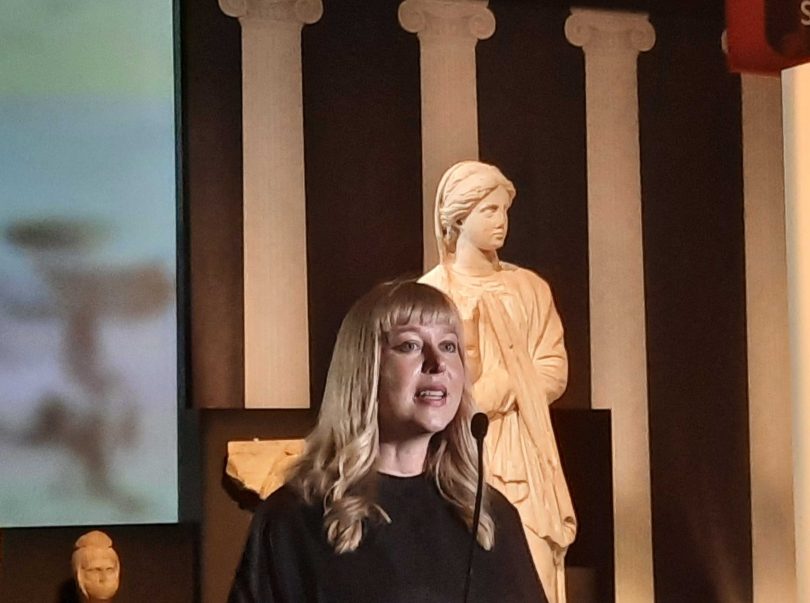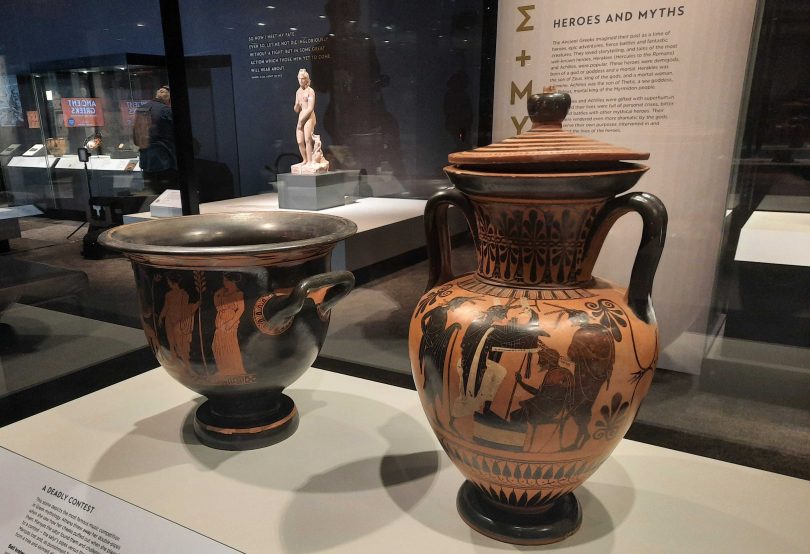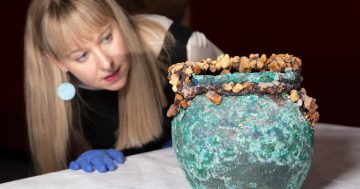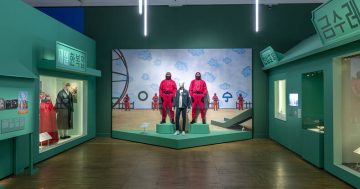
National Museum of Australia curator Dr Lily Withycombe at the ‘Ancient Greeks: Athletes, Warriors and Heroes’ exhibition. Photo: Ian Bushnell.
The subtitle to the ‘Ancient Greeks: Athletes, Warriors and Heroes’ blockbuster exhibition now open at the National Museum of Australia suggests women might not get much of look in.
But that notion is soon dispelled upon entering the gallery and meeting Nike, the goddess of victory, and the other female depictions among the 170 items from the British Museum that will be exhibited during a visit to the east coast of Australia.
‘Ancient Greeks: Athletes, Warriors and Heroes’ explores the competitive nature of the Ancient Greek world, and while there are weapons and armour, there are also terracotta sculptures of women playing a game, marble statues of goddesses and women, decorated ceramics and jewellery.
Fittingly, the mythical Amazons also feature, doing battle with Greek soldiers in a marble frieze.
National Museum of Australia curator Dr Lily Withycombe said British Museum curator Dr Peter Higgs was really keen to make sure women’s voices are shown in the exhibition.
“A lot of these objects present the lived experience of women, and they’re really fascinating because some of them are elite representations of women and they present a very idealised view, but then there’s these smaller terracotta representations of women that shows them in what looks to be their ordinary everyday life,” said Dr Withycombe.
She said as well as depictions of great heroes such as Herakles and Achilles, there are also stories about the great women of antiquity such as Artemisia.
Dr Withycombe said the exhibition gives visitors a glimpse of what it was like to be an Ancient Greek person.
“One of my favourite parts of this exhibition and material culture from the ancient Mediterranean is the red and black figure vases,” she said. “They’re just so richly and vividly detailed.
“They tell these incredibly detailed scenes and present life in ways I’m fascinated by. I learn something new every time I look at them.”
But there is something spinetingling about looking at a set of bronze body armour from 350-300BCE and imagining who wore it and what adventures that warrior had seen.
“One of the things that jumped out at me when I saw it was just how small it is,” said Dr Withycombe.
“It is such a reminder that we were of smaller stature in the ancient world.”
The exhibition stretches across centuries into Roman times, and across the Mediterranean, and includes Roman copies of Greek archetypes such as the discus thrower.
The exhibition is themed along physical exploits, but also communicates the artistic, intellectual and domestic life of the Ancient Greek world.

Some of the amphorae at the ‘Ancient Greeks: Athletes, Warriors and Heroes’ exhibition at the National Museum of Australia. Photo: Ian Bushnell.
National Museum of Australia director Dr Mathew Trinca believes it’s also a celebration of the human spirit that Canberra and the nation needs to have after nearly two years of COVID-19 pandemic restrictions.
“The legacy of Ancient Greece endures in our society, and visitors will be mesmerised by the stories of competition in the Ancient Greek world and by the beautiful depictions of athletes, the ceramics, sculptures, armour and jewellery on show,” he said.
The exhibition will be one of the biggest attractions to the ACT of the summer, and a big contributor to local tourism and the economy in general.
ACT Assistant Minister for Economic Development Tara Cheyne acknowledges how important such an exhibition is on several levels.
“It’s going to play such an important role in enhancing our wellbeing and driving community connectedness while also supporting the social and economic recovery of the Canberra region,” she said.
Dr Trinca acknowledges the support of the Greek community in Canberra, including the Hellenic Club for its support in bringing the exhibition to the ACT.
President of the Greek Orthodox Community and Church John Loukadellis said the exhibition evokes memories of childhood stories and prompted him to think about what it would be like to be an Ancient Greek.
“This is a great Nike, not just for Canberra, but for everyone around Australia who loves culture and ancient civilization stories, and is also a friend of history,” he said.
‘Ancient Greeks: Athletes, Warriors and Heroes’ is currently exhibiting at the National Museum of Australia until 1 May, 2022. Tickets are $28. For bookings, visit here.
Original Article published by Ian Bushnell on Riotact.



